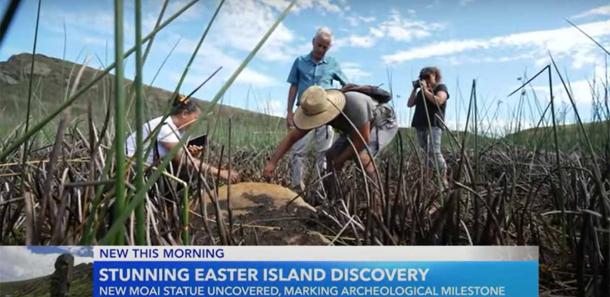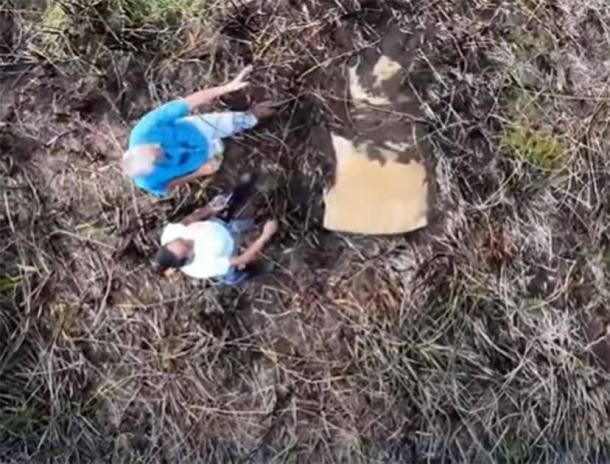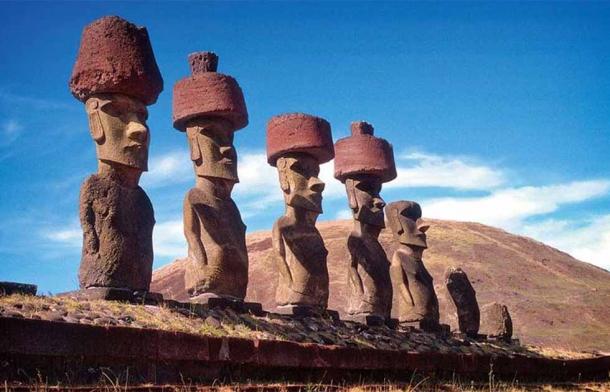
New Moai Statue Found on Chile’s Easter Island Excites Researchers
In the news last October for the damage inflicted by a forest fire over 100 hectares, Easter Island is now in the news again – for the discovery and addition of a new Moai statue on the Chilean island. The discovery was found buried in a dried lake bed, in an area not usually available for access to humans, but now reachable due to climate-change related drying up. It has been described as a “very, very important discovery” for the Rapa Nui people.

Researchers inspect the new-found Moai in the dry lake bed on Rapa Nui. (GMA/YouTube Screenshot)
New Moai Smaller Than Most: Hiding in Plain Sight
The new Moai is smaller than most of the other sacred monuments found on Easter Island - statues that are important markers of Rapa Nui culture and heritage. The Rapa Nui people carved almost 1,000 Moai statues from tuff, a volcanic rock, between the 13th and 16th centuries. The statues are believed to represent ancestors or important leaders of the community and are arranged in a ring around the island, facing inwards.
“The moai are important because they really represent the history of the Rapa Nui people,” Terry Hunt, professor of archaeology at the University of Arizona, told ABC. “They were the islanders’ deified ancestors. They’re iconic worldwide, and they really represent the fantastic archaeological heritage of this island.”
The discovery of the new Moai statue has excited researchers, as it is smaller than most others on the island, and had been hidden by tall reeds in the dry lake bed. Archaeologists believe that there may be more statues to uncover, and are looking for evidence of other Moai as well as the tools that might have been used to make them. The discovery of new Moai statues could provide insight into the culture and traditions of the Rapa Nui people.
- The Return of the Moai: Rapa Nui and the Fight for its Ancestors
- Easter Island and the Mysteries of the Moai

New Moai seems to be lying on the lake bed, and smaller than the existing finds. (GMA/YouTube Screenshot)
“They’ve been hidden by the tall reeds that grow in the lake bed, and prospecting with something that can detect what’s under the ground surface may tell us that there are in fact more moai in the lakebed sediments,” Hunt added. “When there’s one moai in the lake, there’s probably more.”
- Truck Driver Destroys Famous Easter Island Moai Statue
- Photos Reveal Giant Easter Island Moai Statues are Covered in Mysterious Symbols
The Moai Statues and the Rapa Nui People
The Moai statues are one of the most recognizable and fascinating features of Easter Island, which is also known as Rapa Nui. The Moai are large, monolithic stone statues that were carved by the Rapa Nui people between the 13th and 16th centuries. They are thought to represent ancestors or important leaders of the community.
The Moai are made from a volcanic rock called tuff, which is found in several quarries on the island. The statues were carved using stone tools and were transported to their final locations on the island using a system of ropes, ramps, and rollers, reports Artnet News.
There are over 800 known Moai on Easter Island, ranging in height from a few feet to over 30 feet tall. The largest Moai weighs over 75 tons, and it is believed that the Rapa Nui people used a combination of levers and ropes to move the statues from the quarries to their final locations.
The Moai were placed on stone platforms called ahu, which were built by the Rapa Nui people. The ahu served as a ceremonial center and were often located near the coast. The Moai were typically placed with their backs to the sea, facing inland, and were arranged in a line along the ahu.

Moai (stone statues) on Ahu Nau, Anakena Beach, Easter Island, with their backs to the sea. (Guillaume Massardier/CC BY-SA 3.0)
The reason why the Rapa Nui people carved and erected the Moai statues is still a mystery, though it is believed that they may have served as a way to honor ancestors, leaders, or gods. The decline of the Rapa Nui civilization is often associated with the over-exploitation of the island's resources, including the deforestation of the island and the loss of fertile soil, which led to a collapse in the island's agricultural system. The exact cause of the Rapa Nui civilization's decline is still debated among archaeologists and historians.
The Moai statues are vulnerable to damage or attack. For instance, an arsonist set fire to the island last fall, leaving some statues charred and cracked, while in 2020, another was knocked over by a runaway pickup truck.
As a result, there is an ongoing debate about the repatriation of one sculpture, Hoa Hakananai'a, which was taken without permission by the U.K.'s Royal Navy in 1868 and is currently held by the British Museum. In the current political climate, where there are renewed conversations around protecting the heritage of indigenous peoples all over the world, the Rapa Nui people and their cultural heritage hold a vital place in this discourse.
Top image: Stylized AI generated graphic of a Moai statue. Source: artefacti/Adobe Stock
By Sahir Pandey
References
Aton, F. 2023. New Moai Statue Found on Easter Island, Opening the Possibility of More to Be Discovered. Available at: https://www.artnews.com/art-news/news/moai-statue-discovered-easter-island-1234658897.
Bernabe, A.J., et al. 2023. Ancient sculpture discovered on Easter Island: 'GMA' gets 1st look. Available at: https://6abc.com/new-discovery-on-easter-island-moai-statue-statues-michael-strahan/12888512/.
Lawson-Tancred, J. 2023. Archaeologists on Easter Island Have Discovered a Previously Unknown Moai Statue Buried in a Dried-Out Lake Bed. Available at: https://news.artnet.com/art-world/archaeologists-on-easter-island-have-discovered-a-previously-unknown-moai-statue-buried-in-a-dried-out-lake-bed-2261978.
















Comments
The purpose of the big statues was probably to send a message to all who may have wanted to land a boat on the island, saying ‘this is our island, and our big, mean-looking guardians are hungry.’ Maybe they knew at that point the island could barely support the people it had? No animals left, and the smart ones long paddled away on the logs that were the last trees.
Nobody gets paid to tell the truth.